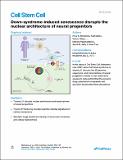Down-syndrome-induced senescence disrupts the nuclear architecture of neural progenitors
Author(s)
Meharena, Hiruy S; Marco, Asaf; Dileep, Vishnu; Lockshin, Elana R; Akatsu, Grace Y; Mullahoo, James; Watson, L Ashley; Ko, Tak; Guerin, Lindsey N; Abdurrob, Fatema; Rengarajan, Shruthi; Papanastasiou, Malvina; Jaffe, Jacob D; Tsai, Li-Huei; ... Show more Show less
DownloadPublished version (5.843Mb)
Publisher with Creative Commons License
Publisher with Creative Commons License
Creative Commons Attribution
Terms of use
Metadata
Show full item recordAbstract
Down syndrome (DS) is a genetic disorder driven by the triplication of chromosome 21 (T21) and characterized by a wide range of neurodevelopmental and physical disabilities. Transcriptomic analysis of tissue samples from individuals with DS has revealed that T21 induces a genome-wide transcriptional disruption. However, the consequences of T21 on the nuclear architecture and its interplay with the transcriptome remain unknown. In this study, we find that unlike human induced pluripotent stem cells (iPSCs), iPSC-derived neural progenitor cells (NPCs) exhibit genome-wide "chromosomal introversion," disruption of lamina-associated domains, and global chromatin accessibility changes in response to T21, consistent with the transcriptional and nuclear architecture changes characteristic of senescent cells. Treatment of T21-harboring NPCs with senolytic drugs alleviates the transcriptional, molecular, and cellular dysfunctions associated with DS. Our findings provide a mechanistic link between T21 and global transcriptional disruption and indicate that senescence-associated phenotypes may play a key role in the neurodevelopmental pathogenesis of DS.
Date issued
2022Department
Massachusetts Institute of Technology. Department of Brain and Cognitive SciencesJournal
Cell Stem Cell
Publisher
Elsevier BV
Citation
Meharena, Hiruy S, Marco, Asaf, Dileep, Vishnu, Lockshin, Elana R, Akatsu, Grace Y et al. 2022. "Down-syndrome-induced senescence disrupts the nuclear architecture of neural progenitors." Cell Stem Cell, 29 (1).
Version: Final published version